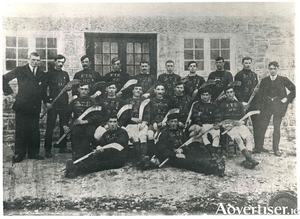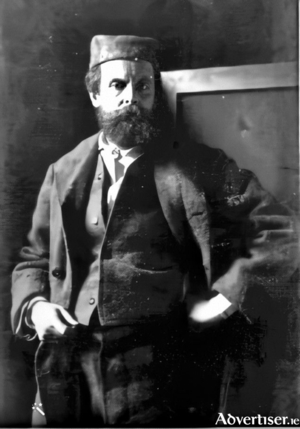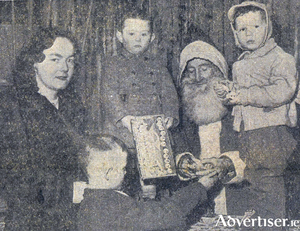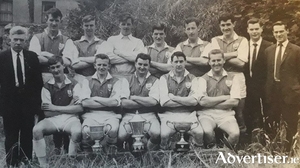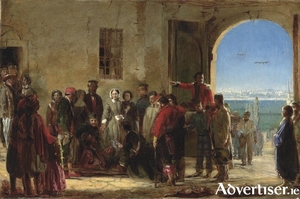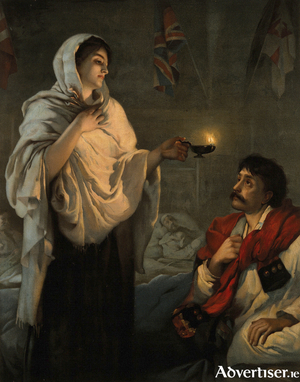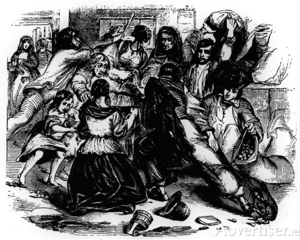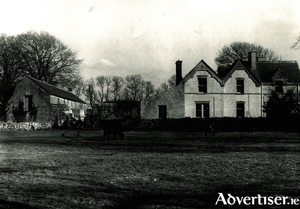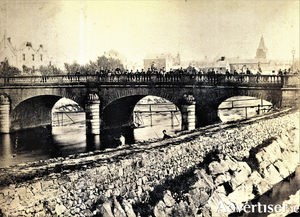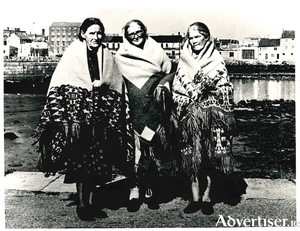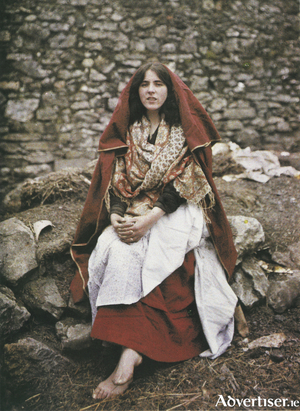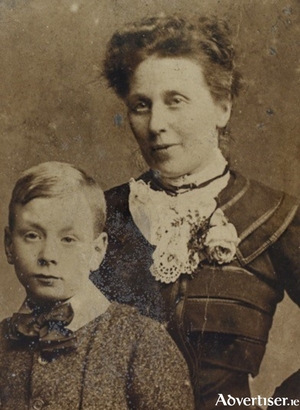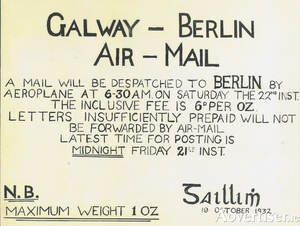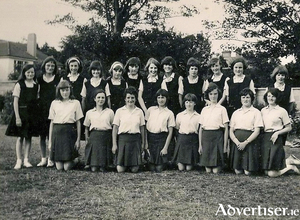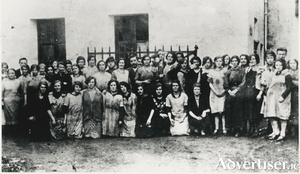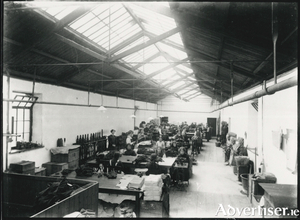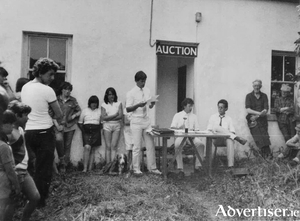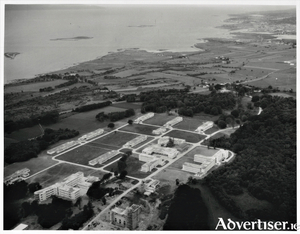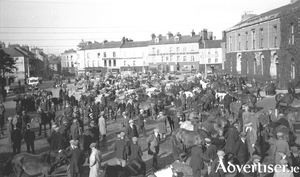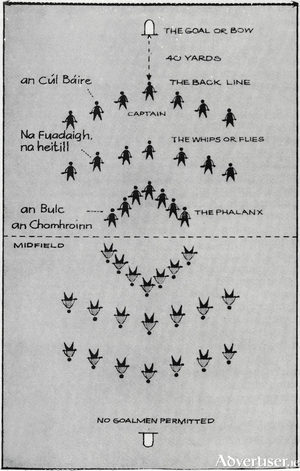In their green and black jerseys, we remember them still
Thu, Jan 05, 2023
Father Tom Burke’s Hurling Club was founded in 1898. It was called after the very famous Galway-born Dominican priest and preacher whose statue can be seen today on Father Griffin Road. Its membership was composed in the main of fishermen from the Claddagh. In their very early days, teams had 21 players.
Read more ...Wilfrid Scawen Blunt in Galway Gaol
Thu, Dec 29, 2022
Blunt was an aristocratic English writer, a person of remarkable ability who, as “the best looking man in England was credited with having refreshed the blood of several ancient families”. He was always against colonialism and sympathetic to small nations, so it was no surprise that he became an ardent supporter of Home Rule for Ireland. In 1887, he was in Ireland to study the grievances of the people when he heard that evictions had recommenced on the 56,000-acre estate of Lord Clanricarde in Woodford.
Read more ...Santa Claus comes to Galway
Thu, Dec 22, 2022
St Nicholas of Myra is the patron saint of archers, sailors, merchants, repentant thieves, brewers, pawnbrokers, unmarried people, students, and children. He is also the patron saint of Galway, and our oldest church, St Nicholas' Collegiate, is named after him. He was a legendary giver of gifts, particularly to the poor. He would hand coins in through windows or open doors, and if they were closed, sometimes he would put them down the chimney. This was the origin of the tradition of Santa coming down the chimney bearing gifts. The tradition was good for business for chimney sweeps, it would be difficult to explain soot marks on the floor on Christmas morning.
Read more ...John Keady, a tribute
Thu, Dec 15, 2022
Now that we are reaching the end of saturation coverage of the World Cup and watching some of the best soccer players in the world, you might wonder where it all began for some of them, how they got themselves on to the world stage, and how much they owe to the unsung people without whom they would never have succeeded, the referees whose dedication to the game make all of those matches possible.
Read more ...Rats ate the nuns’ Christmas dinner Week IV
Wed, Dec 14, 2022
In the hopelessly disorganised Allied army which fought Russia in the Crimean War 1853 - 1856, 15 Sisters of Mercy from Ireland played an heroic role in establishing revolutionary nursing practices in the chaos of the terrible hospitals of the day. They undoubtedly saved hundreds of lives, and brought comfort to the young injured and dying men, and laid out principals for modern nursing which were widely regarded as the standard for decades to come.
Read more ...There was only going to be one ‘Lady of the Lamp’ in Crimea
Thu, Dec 08, 2022
Week III
The Crimean War was a chaotic affair involving Russia, the Ottoman Empire, France and England, over an area disputed for centuries. It lasted from October 1853 until March 1856, costing some 600,000 lives. Initially, like all wars, it was believed that Russia’s land grab in the eastern Mediterranean, would be quickly stopped; but as the months dragged on the armies on both sides were not prepared for the harsh, winter weather, and the length of the conflict. A number of fierce battles were fought including the infamous ‘Charge of the Light Brigade’, and at Sebastopol, Alma and elsewhere causing thousands of casualties for which the military hospitals of the time were hopelessly inefficient, and unable to cope.
The Galway starvation riots
Thu, Dec 01, 2022
Our illustration today was published in the Illustrated London News on June 25, 1842, and was intended to “Convey an idea of the desperation to which the poor people of Galway have been reduced by the present calamitous season of starvation. The scene represented above is an attack upon a potato store in the town of Galway, on the 13th of the present month, when the distress had become too great for the poor squalid and unpitied inhabitants to endure their misery any longer, without some more substantial alleviation than prospects of coming harvest; and their resource in this case was to break open the potato stores and distribute their contents, without much discrimination, among the plunderers, and to attack the mills where oatmeal was known to be stored.
Read more ...Galwegians RFC, one hundred years
Thu, Nov 24, 2022
It is fairly certain that rugby football was being played in Galway before the formation of the IRFU, but the lack of surviving minutes of meetings or records makes it difficult to pinpoint the actual beginnings of some clubs. We know that in 1886 there were four clubs in existence, Queen’s College (now UG), The Grammar School, Galway Town, and Old Galwegians. These latter two clubs amalgamated in the 1909/10 season and called themselves Galway Town. They were a successful club. World War I and its aftermath ruled out competitive rugby but in the resumption, in 1921/22 they again won the senior cup and then, for some reason, decided to change the name again, this time to Galwegians RFC.
Read more ...The Salmon Weir Bridge
Thu, Nov 17, 2022
The foundation stone for this bridge was laid on June 29, 1818, by William Le Poer Trench and the structure was completed the following year. The original purpose was to connect the new County Courthouse with the County Gaol on Nuns' Island. It is a fine gently humped five-span bridge which was originally known as ‘The New Bridge’ or ‘Gaol Bridge’.
Read more ...The Galway shawl
Thu, Nov 10, 2022
The Galway shawl was a specific type of heavyweight shawl worn by women during the cold season. It was very popular during the 19th century and was still being worn by a few older, more traditional, women up until the 1950s. It was worn by women all over Ireland, but for some reason was known as the Galway shawl. It was a winter-weight outer garment and was worn over a lightweight one.
Read more ...Cloaks in old Galway
Thu, Nov 03, 2022
The Irish cloak was a standard 19th century garment worn by women all over the country. It is described as a sleeveless garment reaching to the ankles, open in front and fastened with a hook-and-eye or with ribbons. One width of material goes into the back and a half width into each side. On the shoulder, the material is tightly gauged, and attached to the back of the neck is a large hood which hangs down the back when not in use. The hood, which is lined with satin, silk, or sateen, is made of a rectangular piece of material drawn into pleats at the back. It was constantly used when the cloak was worn, even on hot days, when the hood could be drawn to shield the eyes of the wearer from the sun. The cloak formed very graceful drapery, fell well and folded well, was very elegant and usually large enough to envelop the whole person.
Read more ...War of Friends, Liam Mellows and Pádraic Ó Máille
Wed, Oct 26, 2022
Today we are highlighting the careers of two men, both of whom were elected as TDs for Galway in 1918, both of whom fought on the same side in the Rising and the War of Independence and then, sadly, took different sides after the Treaty.
Read more ...An historic air mail flight from Galway to Berlin
Thu, Oct 20, 2022
Ninety years ago, on October 22, 1932, a Fox Moth plane piloted by Captain Armstrong took off from Oranmore carrying mails and two passengers, Peggy Kenny and Kitty Curran, thus starting the first Irish-Continental European air mail delivery and the first passenger service. The mails were handed to the pilot by the postmaster Mr C Lynch. Bad weather at Athlone meant they had to fly blind a few hundred feet above ground for some time. This ‘feeder’ part of the overall journey was sponsored by Galway Harbour Board to the tune of £80. The flight took 55 minutes, it took the ladies four hours to get home on the train.
Read more ...Salerno, sixty years of secondary education
Thu, Oct 13, 2022
In the late forties and early fifties, the population of Salthill began to grow dramatically with the building of lots of individual houses and estates such as Devon Park and Ard na Mara. There was a national school at Nile Lodge but it was full to capacity, so the bishop invited the Sisters of Jesus and Mary to open another one.
Read more ...The Galway Woolen Mills
Thu, Oct 06, 2022
In 1895, the Galway Woolen Mills opened in Newtownsmith on land that was owned by Marcella Burke. The project was set up to provide employment, especially for young women, rather than to generate profits. Fr Dooley, the diocesan administrator, was the driving force behind the project and it was known locally as “Fr Dooley’s Mill’ long after he died in 1911. He took over three houses in order to build the mill. The hours were long and the pay was not great, 7/6 for women and 18 shillings for men.
Read more ...The Corrib Hosiery Factory
Thu, Sep 29, 2022
This factory was situated in Newtownsmith in a tall building that later became part of the ESB complex. It was quite a big employer of the day in the city, employing mostly young girls and women.
Read more ...Galway auctioneers
Thu, Sep 22, 2022
An auctioneer is described as an agent who accepts bids and sells goods at auction. The profession goes back thousands of years. In ancient Babylon, for instance, they used to hold auctions of women for marriage, indeed it was considered illegal to allow a daughter to be sold outside the auction process. In ancient Rome, they regularly held slave auctions. The idea of auctions as we know them today began in England in the late 17th century. They were referred to as English auctions where bids came in an ascending order.
Read more ...Merlin Park Hospital
Thu, Sep 15, 2022
Tuberculosis is an infectious and very debilitating disease that affects the lungs. It was previously known as consumption because of weight loss suffered.
Read more ...Horse trading in Eyre Square
Thu, Sep 08, 2022
One of the earliest associations of Eyre Square with the horse was the jousting competitions that went on there in the middle ages. There were also horse fairs held in the Square where one could buy and sell horses, these were usually held outside the railings and on the streets. Before motorised machinery was invented, the horse provided people with their main type of transport: the work horse was an invaluable part of the farm used to pull the plough or haul the farmer and his cartload of produce into town. Horse racing was always a popular sport and the first Galway Horse Show was held in the Square in 1892.
Read more ...Hurling — game of legend and of legends
Thu, Sep 01, 2022
Hurling is one of the oldest field games in the world. Some stories portray it as a form of military training, proficiency on the field equated with skill in battle. Legend has it that the first battle of Moytura fought about 2000 B.C. between two rival tribes, was preceded by a fierce hurling match between two teams of 27 a-side drawn from opposing forces. The casualties were buried under a huge stone cairn – a megalithic tomb. The field where the game took place is still called The Field of the Hurlers. Ancient games were also played at Tara.
Read more ...